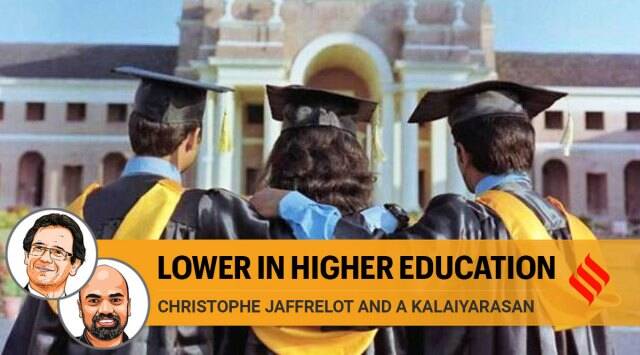Muslims in higher education: A sobering tale
Data points to falling Muslim enrolment. This level of absolute decline has not happened in the recent past for any group
source: Indian Express
The recently released All India Survey on Higher Education 2020–21 shows some contrasting trends. On the one hand, enrollment of Dalits, Adivasis and OBCs in higher education has increased by 4.2 per cent, 11.9 per cent and 4 per cent respectively compared to 2019-20. The upper castes, whose share in enrollment had been declining with the implementation of Mandal II since the late 2000s but who have come back with the highest growth rate of 13.6 per cent. On the other hand, the enrollment of Muslim students dropped by 8 per cent from 2019-20 – that is, by 1,79,147 students. This level of absolute decline has never happened in the recent past for any group.

UP accounts for 36 per cent of that total decline followed by Jammu and Kashmir, which accounts for 26 per cent, then Maharashtra (8.5 per cent), Tamil Nadu (8.1 per cent), Gujarat (6.1 per cent), Bihar (5.7 per cent) and Karnataka (3.7 per cent). Except in Tamil Nadu, Muslims alone witnessed an absolute decline in their enrollment. While the states that have a larger share of the Muslim population account for the higher share of decline, small states too show similar trends. For instance, between 2019-20 — 2020-21, Delhi lost about 20 per cent of its Muslim students while J&K lost about 36 per cent.
If we strictly follow the age cohort 18-23, the PLFS data confirms this trend. Muslims do even worse than Dalits and Adivasis. According to this source, only about 19 per cent are currently attending higher education institutions, as against 21 per cent among Adivasis, 26 per cent among Dalits, 34 per cent Hindu OBCs and 45 per cent Hindu upper castes. Among major states, in 2020-21 in no state did Muslims do better than Dalits except in Tamil Nadu, Telangana and Delhi. Advasis do better than Muslims in many states such as Rajasthan, Assam, Gujarat, Maharashtra and Jharkhand.
Being the most populated state, UP pulls down the national average. Muslims, who account for about 20 per cent of the state’s population, have just 4.5 per cent of total enrollment. UP alone witnessed the dropout of 58,365 Muslim students from 2019-20 — a decline of 16 per cent. If UP illustrates the story of the deepening deprivation of Muslims, Kerala offers a story of upward mobility. Kerala has not only seen positive growth in enrolment, it also tops in the percentage of Muslim youth (43 per cent) who are currently attending higher education. The century-old positive discrimination in favour of Muslims has helped the community to build educational capital in the state.
Muslims in Kerala enjoy 10 per cent reservation in government jobs and 12 per cent in educational institutions. After Ezhavas (14 per cent), Muslims form the largest population who also claim a large share of quota in the state’s OBC list.
While the sources of marginalisation began much before, what is new is the acceleration of such marginalisation in recent times. How can this be explained? A few factors might have played a key role in the context of rising Hindu majoritarianism.
First, the future is bleak as job opportunities have been shrinking for Muslims even more than for others — they face the highest unemployment rate among socio-religious groups. The percentage of regular/salaried workers who did not report work during the reference week for Muslims rose from 1.6 per cent in 2018-19 to 13.2 per cent in 2019-20. This data is partly a reflection of some discrimination in the job market – an old trend that has been documented by surveys: You send the same CV with Brahmin names, Dalit names and Muslim names, and the percentage of those invited to an interview is the lowest in the case of the latter.
Second, in such a bleak context, one may not have enough money for studying and may, on the contrary, need to work to make a living. Hence, the high dropout rate among Muslim youth who continue with the kind of manual work and low-paying self-employment the community is known for, such as weaving and car repair.
Third, increased violence against Muslims has restricted their spatial mobility and has forced them to withdraw into their shells, a development evident from the ongoing process of ghettoisation in almost all Indian cities.
In this context, the only reasonable policy for the government, as the Sachar Committee Report and (even more) the Mishra Report recommended, would be to initiate positive discrimination in favour of Muslims — something some southern states have done successfully. On the contrary, the state support for Muslims has come down. Karnataka which had been providing Muslims a sub-quota — 4 per cent within the OBC quota — was scrapped recently by the BJP government. The Ministry of Minority Affairs has stopped the Maulana Azad Fellowship — dedicated to pursuing higher education — for minority students from 2022-23.
Where else have we seen a constant policy of discrimination vis-à-vis a vulnerable minority targeting their access to higher education? Only in countries where the intention was to manufacture second-class citizens. And there it worked, but never resulted in harmonious development.


Recent Comments